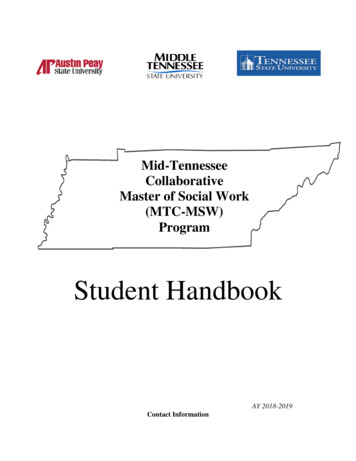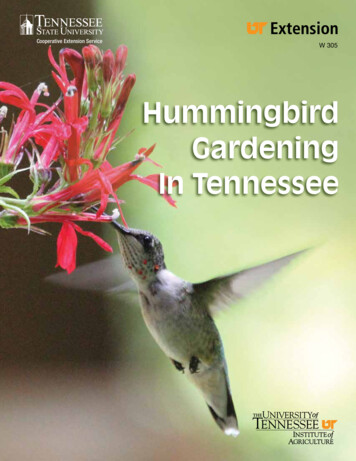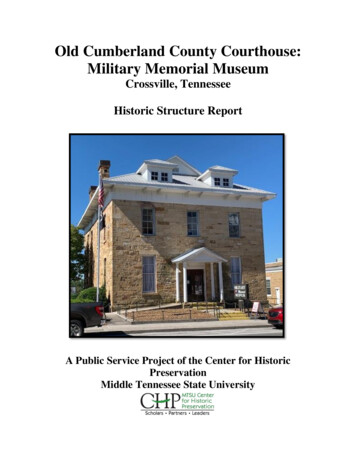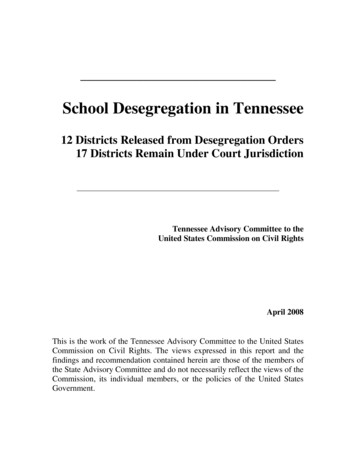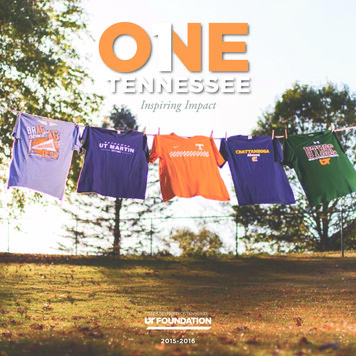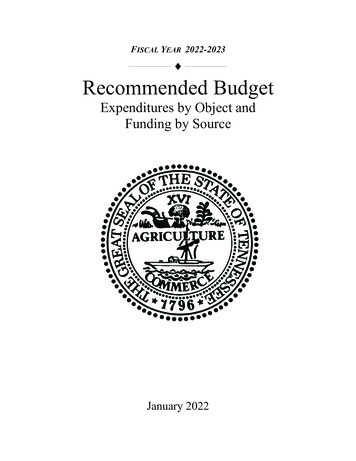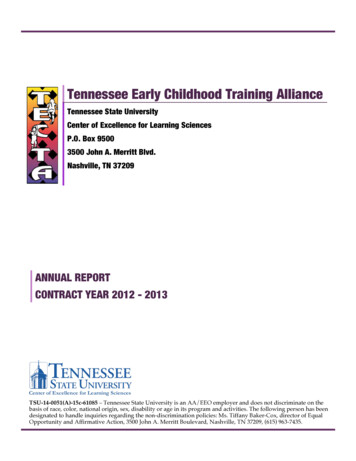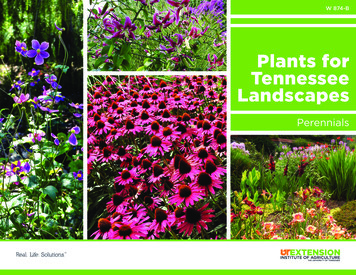
Transcription
W 874-BPlants forTennesseeLandscapesPerennials
Perennials for Tennessee LandscapesCeleste Scott, Extension Agent, Madison CountyCarol Reese, Western Region, Horticulture Extension SpecialistLee Sammons, Extension Agent, Hardeman CountyLucas Holman, Extension Agent, Wilson CountyJoellen Dimond, former Extension Agent, Tipton CountyNatalie Bumgarner, Residential and Consumer Horticulture Extension Specialist, Department of Plant SciencesIntroductionPerennials can live for many years, even decades, although some are not that durable. The lifespan of those shorter-lived perennials may be geneticallydetermined, while others may be poorly adapted to the region or poorly sited in the garden.The terms “tender perennial” or “half-hardy annual” are sometimes used to describe groups of plants that can survive mild winters in the area but are killed bycolder temperatures. If planted a zone farther south, they would likely be rated truly perennial to that zone. Perennials can be planted year round if they areconsidered to be very hardy to your region. If they are marginally hardy, it is best to plant in spring to ensure root is established before the onset of winter.Perennial plants are grown for flower and foliage interest. Most blooming perennials have a relatively short bloom period compared to annual bedding plants, butthat is not necessarily a negative trait. Many perennials have handsome foliage that contributes to the overall aesthetic of the design and may in fact be plantedprimarily for their foliage and not the flower (e.g., Hosta, Heuchera, Artemisia and Sedum). Beautiful foliage can complement neighboring bloomers and evenconceal tattered foliage of those plants who have passed their peak.Those plants with interesting foliage offer much potential for exciting designs. Consider golden foliage against dark, wispy graceful foliage against bold coarseleaves, or inserting strongly vertical species to break up a garden of mounded growth habits. Evergreen perennials can also play strong roles in winter interest,and when planted in mass, could function as groundcovers. In these scenarios, the flowering season is just a bonus.Another asset of perennials is that they can often be divided to create new plants for the garden or to share with other gardeners. In fact, some perennials mayrequire occasional division to look their best or as flowering performance declines.The purpose of this list is to provide Tennessee gardeners with a basic guide to common perennials that are proven through trials, are easily found in the trade,and perform well in Tennessee landscapes. Please note that the cultivar list is not all-inclusive. We have attempted to include the most reliable selections, but notnecessarily the newest introductions. This list is evolving, and as newer selections are proven through garden trials across our state, we will amend it to reflectthose plants most suited for Tennessee. In order to adequately cover some of the broader categories of herbaceous perennials, specific categories including bulbs,ferns, tropicals, ornamental grasses and grass-like plants are included in separate lists.Perennials for Tennessee Landscapes1
How to Read TablesKnowing plant names and characteristics is important, but the crucial step in successful gardening is placing them in appropriate sites in terms of climate, soilcondition and sunlight. This publication provides guidance in those areas to assist gardeners in siting plants for optimal performance and function in the landscape.Plants are ordered alphabetically by scientific name. Common names are also included for ease of reference.Zone: USDA hardiness zone based on the annual minimum winter temperature https://planthardiness.ars.usda.gov/PHZMWeb/Light Needs:Sun — site receives at least six hours of direct midday or afternoon sun.Part Sun — site receives at least four hours of direct sun in any site or up to six hours of morning sun.Shade — site receives less than four hours of direct sun or filtered/dappled light.Bloom or Foliage Period: General period of bloom in Tennessee and/or identifies plant specifically as one used for foliage.Cultivars of Note: Cultivars are in ‘quotations’, and Series are denoted by bold typeface. (A plant series is essentially a breeding line of plants that retain the samedesirable characteristics but in different colors.)Comments: Lists special attributes, helpful siting information, and design functions in the landscape.CommonNameZoneAchillea spp.Yarrow3-91.53’H&WXPartSunXAgastache spp.Agastache4-82-4’H1.5-3’WXXXXScientific NameSizeBloom orFoliageShade PeriodLight NeedsSunCultivars of Note CommentsJuneSeptember‘Coronation Gold’‘Paprika’‘Moonshine’Drought tolerant. Attracts pollinators andbeneficial insects. Cut flower. Some spread.JuneSeptember‘TangerineDreams’ ‘HeatherQueen’ ‘BlueFortune’ ‘GoldenJubilee’Requires good drainage, attracts pollinatorsand hummingbirds, and can be short lived.Kudos SeriesAjuga spp.Bugleweed4-9.5-.75’H1WAmsonia hubrichtiiArkansasBlue ontanaCommonBlue Star3-92.5-3’H4-5’WXXApril-MayPerennials for Tennessee LandscapesXMay-June‘Black Scallop’‘Caitlin’s Giant’‘Chocolate Chip’‘Dixie Chip’—variegated‘Blue Ice’‘Storm Cloud’Evergreen ground cover. Some cultivars maybe short lived.Feathery foliage lends great texture toborders. Has golden/copper fall color andtolerates poor dry soil.Wider leaf than Arkansas Blue Star. Hasgolden fall color and tolerates average tomoist soil.2
CommonNameZoneAnemonehupehensis l-JuneAquilegia gbird SeriesBarlow SeriesOrigami SeriesAralia un King’Artemisia e‘Powis Castle’‘HuntingtonGarden’‘Silver King’‘Silver Queen’ArtemisiastellerianaArtemisia vulgarisArum italicumWormwood5-81’HXXFoliageMugwortItalian Arum4-95-93’H1-1.5’H&WXXXAruncus spp.Goatsbeard4-71.5-6’HAsarum splendensChineseWild Ginger6-9.5’HScientific NamePerennials for Tennessee LandscapesSizeBloom orFoliageShade PeriodLight d FruitsummerCultivars of Note Comments‘SeptemberCharm’ ‘HonoineJobert’‘Whirlwind’Can be an aggressive spreader in idealconditions.Attracts hummingbirds. Short lived, but reseeds in happy locations. Foliage fades andcan disappear in the heat of summer. Leafminer damage is cosmetic, native.Attracts hummingbirds. Short lived, but somecultivars re-seed in happy locations. Foliagefades and can disappear in theheat of summer. Leaf miner damage iscosmetic.Yellow to chartreuse foliage is a great additionto shady sites. Dies back to theground in winter. Shrubby appearance ingrowing season.Grown for silvery foliage. Needs gooddrainage. Prune only after last frost.Grown for silvery foliage and cut flowerfiller. Aggressive grower and spreader.‘Silvermound’Soft, feathery foliage. Aromatic. Needs gooddrainage. Best suited to cooler, lesshumid regions of the state.‘Silver Bullet’‘Silver Brocade’‘Limelight’‘Pictum’Grown for silvery foliage. Habit is trailingbut not spreading.Aggressive grower, and spreading.Handsome winter foliage. Has attractive redsummer fruit while foliage is dormant.Tolerates heavy shade and wet soil. Can reseed and become a troublesome spreader.Moist shade. Best suited in cooler regionsof Tennessee. Low maintenance.Spreads slowly by rhizomes. Has beautifulsilver foliage and is semi-evergreenXMay-June‘Misty Lace’XFoliage‘Quick Silver’3
5’HXPartSunXAsclepias tuberosaButterflyWeed3-91-2.5’H1-1.5’WXAster tataricusTatarianAster3-93-6’HXAstilbe spp.Astilbe3-81-1.5’H&WBaptisia spp.False Indigo3-92-5’H&WBegonia nensisBlackberryLily3-91.5-3’H1-1.5’WBuddleia davidiiButterfly BushCanna spp.CannaScientific NamePerennials for Tennessee LandscapesSizeSun‘Cinderella’‘Ice Ballet’XJuneSeptember‘Hello ��Blue/purple/ yellow/ Tall forms may need staking. Tolerates poorsoils and drought. Suitable for rainwhite/pink Manygarden. Native. Has interesting seed podscultivarsand unique foliage.Pink and whitePrefers moist, rich soil and tolerates heavybloomsshade and walnut trees. Reseeds/naturalizes gracefully.Attractive iris-like foliage that has a niceOrange flowerscontrast to other perennials. Seed pods arewith group of darkattractive and used for arrangements.purple seed headsRe-seeds.that resembleblackberries.XXXXX4-7’HXCultivars of Note CommentsJuneAugustXX7-9Bloom orFoliageShade PeriodLight ust‘BlackKnight’‘Blue Chip’‘Miss Ruby’FoliageSummerFrost‘Bengal Tiger’‘Tropicanna’Prefers wet soil. Serves as a host plant forMonarch caterpillars and is known forshowy blooms in pink and white. Aphids canbe an issue.In cultivation and found along roadsides inTennessee. Tolerates drought. Is a host plantfor Monarch caterpillars and is known forshowy blooms in orange and yellow. Aphidscan be an issue.Light purple bloom with yellow center.Basal foliage is 1.5 ft tall; bloom stalks are4-6 ft. tall. Slowly colonizes.Tolerates heavy shade. Foliage burns up inlate summer. Best suited for cool damp sitesand can grow under a walnut tree.Considered a tender woody perennial inmany areas of the state, older cultivarstend to be more hardy. Many new cultivarsare being hybridized for compact growth.Good source of nectar for manypollinators. Sterile forms are available inareas where invasiveness is an issue.Tolerates drought stress and flourishes inwet sites. Should be lifted in winter in wetsite. Hardiness is cultivar dependent.Cannova series is seed grown andmarginally hardy.4
CommonNameZoneCeratostigmaplumbaginoidesHardy .Hardy Mums5-91.5-2’H1-1.5’WXXSeptember-FrostClematis spp.Clematis3-9VineXXSpring andfall in coolseasonsScientific NameSizeBloom orFoliageShade PeriodLight NeedsSunCultivars of Note k/Yellow’‘Clara Curtis’‘Ryan’sPink/Yellow’Foliage turns red-orange in the fall and hassmall, true-blue flowers during the growingseason. Has spreading ground cover and likesafternoon shade in hot climates.Needs well-drained soil. Growth is leggyand natural in appearance. Igloo series iscompact. These are not to be confused withpot/Belgian mums used for fall color, whichare best treated as annuals.Igloo Series‘Jackmanii’‘Rooguchi’‘Princess Diana’Many sis hybridMouse darPinks6-9.5’ HXXApril-Junesometimesagain infall‘Firewitch’‘Bath’s Pink’Perennials for Tennessee LandscapesSummer‘Jethro Tull’‘Nana’‘Early Sunshine’‘Rising Sun’Uptick SeriesPrefers cool roots shaded from sun in welldrained soil. ‘Sweet Autumn’ has showyfragrant small white blooms around LaborDay and is an aggressive grower. ‘Armandii’is evergreen and mainly grown for foliage.Marginally hardy.Heat tolerant. Attracts butterflies andsongbirds.Large, deeply cut leaves. Has larger bloomsand is a short-lived perennial but re-seeds.Many new exciting forms and color that needto be proven durable.This series offers ‘Yellowand Red’ and ‘Gold and Bronze’ as colorcombination options. Long bloom period andno deadheading required.Can re-seed. Grows in most soil conditions.There are many good varieties forTennessee, and is hardiest of other species.Short-lived perennial. Does best in coolerregions.Not well suited to many parts of Tennessee.The alternative is the re-seeding annuallarkspur. See annual seed chart.Tolerates deer and poor soil conditions,requires good drainage, has potential forground cover, and is evergreen.5
CommonNameZoneBloom orFoliageShade PeriodCultivars of Note eflower3-91-1.5’H&WXApril-July‘King of ��H1-2’WBarrenwort5-9.5-1’H1-1.5’W‘Gold ite Swan’‘Kim’s Knee High’‘Pow Wow WildBerry’‘Cheyenne Spirit’‘Sulphureum’Many speciesEpimedium spp.Euphorbiaamygdaloides a talPlain JoePye cientific NameDicentra eximiaDicentraspectabilisEchinaceapurpurea andhybridsPerennials for Tennessee LandscapesSizeLight FoliageApril-JuneChartreusebractsFoliagePrefers moist, humus soils. Foliage does notgo dormant during the summer. Can be shortlived. Native. Attracts birds.Old-fashioned bleeding heart. Foliage willdisappear in the heat of summer.Not all hybrids do well in Tennessee. Somecan be tender perennials but may re-seed.Needs well-drained soil, deer tolerant,beneficial to wildlife and pollinators, and isshort lived but re-seeds.Grows well in dry shade, some forms aretruly evergreen, clumping and spreadinghabit, many species available, underutilizedin Tennessee.Prefers dry, well-drained soil. Spreads. Isuseful as a ground cover and is deer resistant.Contact dermatitis to some.Drought tolerant and evergreen.‘Tazmanian Tiger’‘Ruby Glow’‘Ascot Rainbow’Best grown in less humid climates ofTennessee. Contact dermatitis to some.Deer resistant.JulySeptember‘Little Joe’XJulySeptember‘Bartered Bride’Straight species are also good gardenplants. Butterflies are attracted to thisperennial. It tolerates wet soil and can beused in rain gardens.Straight species are also good gardenplants. Butterflies are attracted to thisperennial. It tolerates wet soil and can beused in rain gardens. ‘Bartered Bride’performs better in cooler climates.XJulySeptember‘Gateway’Straight species are also good garden plants.Butterflies are attracted to thisperennial. It tolerates wet soil and can beused in rain gardens.6
CommonNameZoneSweet JoePye XGaura anium lianthusangustifolius,tuberosa,maximiliani, �H2-3’WXXJuneAugustHelleborus hybridsLenten Rose4-91-1.5’H&WXFebruaryMayEvergreen foliage. Often short lived in theSoutheast. Prefers moist, well-drained soiland is deer and vole resistant. Manycultivars are still under evaluation.HelleborusorientalisLenten s3-101-6’HEvergreen foliage. Long lived. Prefers moist,well-drained soil and is deer and voleresistant. Will re-seed and naturalize.There are enough cultivars to have bloomsall season; some re-bloom. It isa reliable perennial for Tennessee.Will be addressed in an additional chart.Scientific diaPerennials for Tennessee LandscapesSizeBloom orFoliageShade PeriodLight NeedsSunCultivars of Note CommentsJulySeptember‘Little Red’Straight species are also good. Butterflieslove this perennial. It tolerates wet soil andcan be used in rain gardens.June-FrostMesa SeriesArizona SeriesShort-lived perennial. Re-seeds. Likes welldrained soil, is drought tolerant, and is goodfor continuous blooms to attract butterfliesand pollinators.Native. Attracts pollinators. Straight speciesare also good garden plants. Tolerates heatand humidity. Performs best in well-drainedsoil.‘Goblin’‘Heat it le White''Belleza Pink’'Siskyou Pink'‘Rozanne’‘Biokovo’‘Dark Reiter’‘Johnson’s Blue’Mounding habit. Tolerates drought andprefers part sun in West Tennessee.These native perennial sunflowers are bestsuited for gardens with plenty of room. Hasmulti-branched, masses of yellow flowers.Suckers from underground rhizomes.‘Summer Sun’‘Sunburst’Tolerant of poor soils and drought. Attractsbutterflies.7
CommonNameZoneHeuchera hybridsCoral Bells4-91-2’H.5-1’WHeucherella spp.Foamy Bells4-91-1.5’H&WHibiscus yOctoberHibiscusmoscheutos toberHostaHosta3-8.25-3’H.5-5’WXXFoliageIris cristataCrested Iris3-8.5’HXXSpringIris hybridaLouisianaHybrids4-92-4’HXXSpringIris hybridaBearded Iris3-101.5-3’HXXSpringRefer to irissociety awardwinnersIris pallidaSweet Iris4-92-4’HXXFoliageSpring‘Argentea- variegata’‘Variegata’Scientific NamePerennials for Tennessee LandscapesSizeCultivars of Note CommentsPartSunXBloom orFoliageShade mn Bride’‘Delta Dawn’‘Frosted Violet’XXFoliageMay-June‘Alabama Sunrise’‘Fire Frost’‘Stoplight’‘Solar Power’Bloom usuallyred.Alba is a whiteform.Light NeedsSunSummerificSeries‘Moy Grande’‘Fire Ball’Refer to localHosta societies‘Alba’‘TennesseeWhite’Voles are attracted to this perennial. Manycolorful foliage cultivars are available. Notall are hardy in Tennessee, but H. villosahybrids provide heat tolerance. Likes welldrained soil. Colorful foliage can withstandmore light. Can be short lived.Short bloom period, attracts butterflies, hasgood fall color, needs well-drained soil, andprefers more moisture than Heuchera. Shortlived.Tall, airy form, with bold foliage. Prefersaverage to wet soils. Has beautiful redblooms in summer.Bold foliage provides contrast and interest.This species has the largest sized blooms.Tolerates many soil types. Voles like to eat theroots. Many sizes, shapes, patterns, andfoliage colors are available making this aversatile addition to shady landscapes.Hosta are addressed in more detail in aseparate publication.Native, woodland ground cover suitable forshade. Is good for spring color and has a bluebloom.Prefers wet sites and can tolerate averagemoisture. Colors vary and include red.Requires good drainage and dividing toencourage good bloom. Great cut flower.Iris germanica is considered the father ofmodern bearded iris cultivars. Purple iris(bearded) in general is recognized asTennessee’s state-cultivated flower.Best used for attractive variegated foliage.Has blue blooms and a sweet fragrance.8
CommonNameZoneIris pseudacorusYellow Flag5-92-3’HXPartSunXIris sibericaSiberian Iris3-92-3’HXIris tectorumRoof Iris4-81-1.5’H2-3‘WIris versicolorBlue Flag3-9LavendulaLavenderLeucanthemum xsuperbumScientific NameSizeBloom orFoliageShade PeriodLight NeedsSunCultivars of Note CommentsSummer‘Variegata’‘Rising Sun’Aggressive in wet soils. Can be controlledbetter in drier soils. Blooms yellow.XFoliageSpring‘Butter and Sugar’‘Ceaser’s Brother’Has attractive grassy foliage, tolerates wetsoil, and blooms in white, blue and yellow.XXFoliageEarlysummerHandsome evergreen foliage. Clumpy habit.Blue and white blooms.2-2.5’H&WXXSpringWill naturalize to form colonies particularlyin wet sites, which it prefers. Blooms blue.5-82-3’H&WXShastaDaisy5-91-3’HXLiatris spp.Liatris3-92-3’H1’WLysmachia spp.CreepingJenny3-9Monarda didymaBee BalmNepeta racemosaJuneAugust‘Phenomenal’Perfect drainage and air flow for idealsiting. Does not like humid weather.XJuneSeptember‘Alaska’ ‘Becky’Likes well-drained soil, spreads slowly, andcan be divided.XXJulyAugust‘Kobold’Up to.5’HSpreadsXXFoliageEvergreen‘Aurea’ grown forchartreuse foliage4-92-4’H2-3’WXXJuneAugust‘Jacob Kline’‘Raspberry Wine’‘Fireball’Native. Needs well-drained soil, isattractive to pollinators, has good verticalshape in the garden, and is a great cutflower.Trails in the container or garden. Evergreenbut foliage is bronzed in winter. Use withcaution near wetlands because of spreadingnature.Attractive to hummingbirds and pollinators.Has unusual bloom shape in the garden. Lookfor mildew-resistant cultivars. Spreading.Catnip3-72-3’H&WXX‘Walker’s Low’Oxalis ia hybridsPeony4-82.5-4’H&WXXMarch-MayPerennials for Tennessee LandscapesPollinators and cats likethis plant.Low maintenance and can be difficult toget rid of after it establishes in an area.Purple-leafed variety is most popular.Some are marginally hardy.Showy bloom. Some are very fragrant. Needsgood drainage. Plant shallowly. Deerresistant and can be extremely long lived.9
XPhlox divaricataWoodlandPhlox3-81-1.5’HXXPhlox hybridsPhloxVariableVariousXPhlox paniculataGardenPhlox4-83-5’HPhlox stoloniferaCreepingphlox2-8Phlox cientific NameSizeBloom orFoliageShade PeriodLight NeedsSunPartSunXCultivars of Note CommentsMay-July‘Huskers Red’Native, drought tolerant.FoliageJulyOctober'Blue Spire''Filigran' CompactSelections‘Little Spire’‘Lacy Blue’EarlySpring‘Blue Moon’XMay-June‘Minnie Pearl’‘Wanda’Low maintenance, attracts pollinators,requires excellent drainage, not tolerant ofheavy clay soil, and drought tolerant. Don’tcut back until after danger of frost haspassed in the spring. Does not prefer ourhumidity.Native woodland plant. Can perform in fullsun as well. Fragrant and butterflies like it.There are also white forms. The bloomperiod is short.Wanda is long blooming. Mounding form.New hybrids are being developed.XXJuneAugustLook for mildew resistance.5-1’H1-1.5’WXXSpring‘David’ ‘PeacockWhite’ ‘RobertPoore’‘Blue Ridge’‘Sherwood ��H2-3’WXXJuneSeptemberTolerates clay soil, fragrant, spreading, seenoften on slopes, drought tolerant, andnative.Tolerates clay soil and deer. Attractshummingbirds. Seal3-82-3’H.5-1’W‘Blue Emerald’‘Drummonds Pink’‘Snowflake’‘Vivid’‘Miss Manners’‘Pink Manners’‘Crystal gwort3-8.75-1’H1.5-2’WRudbeckia fulgidaRudbeckia3-82-3’H2’WPerennials for Tennessee LandscapesXXXXNative, ground cover.XApril-MayTolerates poor and wet soils.XApril‘Raspberry Splash’‘Trevi Fountain’‘Diana Clare’Tolerates deer and heavy shade. Lowmaintenance when established. Longifoliaand its hybrids are the most heat tolerant.JuneOctober‘Goldstrum’‘Little Gold Star’Re-seeds and multiplies in clumps. Canbecome weedy. Beautiful, native andbeneficial to birds.10
nPetunia5-83-5’ HXX3-102-3’ HXX7-103-4’HXXSalvia greggiiAtumn Sage7-102-3’H3-4’WXSalvia guaraniticaBlue AniseSageMexicanBush Sage7-107-102-5’H3-4’W4-5’H&WSalvia nemorosaViolet Sage4-8Salvia uliginosaBog rCottonScientific NameRudbeckiasubtomentosaRudbeckia trilobaRuellia simplexSalvia leucanthaPerennials for Tennessee LandscapesBloom orFoliagePeriodCultivars of Note CommentsLatesummerLatesummerSummer‘Henry Eilers’‘Little Henry’XSummerthroughfall‘Furman’s Red’‘Lipstick’‘Pink Preference’‘Wild Thing’XXSummer‘Black and Blue’XXFall‘Midnight’‘Santa Barbara’1-2’HXXSummer‘May Night’ ‘NewDimension Rose’6-95’HXXSummer6-81-2’H2’WXSizeLight orders. Native plant gardens, Good cutflower and beneficial to birds.Borders. Native plant gardens. Good cutflower and beneficial to birds.Marginally hardy in zone 7. Thrives in moistsoils, tolerates high heat and humidity, reseeds and multiplies by rhizomes. Preventnaturalization in wild areas.Needs well-drained soils. Shrubby andwoody. Can be evergreen. Prune if scraggly.Attracts pollinators andhummingbirds. Has long bloom season andblooms in pink, red, purple and white.Attracts hummingbirds. Not perennial incolder parts of Tennessee. Blue blooms.Prefers good drainage, especially in winter.Marginally hardy in West to Middle TN, andgenerally not hardy in the Eastern regions.Velvety textured purple blooms with whitetips in the late fall.Prefers dry soil. ‘May Night’ has an early andshort bloom period. Re-blooming series likeLyrical and Profusion are being developedand trialed. Drought and deer resistant.Blooms in purple, pink and white.Sprawling and aggressive. Attractspollinators.Known more for its evergreen foliage color,texture and scent. Has yellow blooms, doesnot like humidity, prefers dry-medium soiland excellent drainage. Well suited forxeriscape/rock gardens.11
-.75’HXXSedum pallidumvar. bithynicunStonecrop3-8.5’HXXSedum reflexum3-9.25-.5’HXXSedum rupestreSpruceSedumStonecrop5-8.25-.5’HXXSedum 75’HX5-8.25-.5’HSempervivumHen ago rugosaSolidagosphacelataScientific NameSizeLight NeedsSunPartSunShadeBloom orFoliagePeriodCultivars of Note �HPerennials for Tennessee LandscapesKnown more for its evergreen foliage,color, texture and scent. Yellow blooms.Does not like humidity, prefers drymedium soil and excellent drainage. Wellsuited for xeriscape/rock gardens.Requires excellent drainage. Has showierflowers than most. Yellow blooms. Semievergreen.Spreading ground cover. Needs dry sites.Has yellow blooms.‘Blue Spruce’Beautiful blue foliage and is an excellentground cover.Colorful foliage changing in winter.‘Autumn Joy’Many othercultivars‘Atlantis’variegated‘Coral Reef’Fall blooms in pink.Long lived.FoliageNumerouscultivarsTolerates drought and poor soil; prefersrocky well-drained soil. Evergreensucculent. Great for containers as well.Prefers cooler parts of Tennessee.XAugust –October‘Golden Baby’‘Little Golden Fleece’Tolerates drought and poor soil. Deertolerant, has yellow blooms, attracts beesand butterflies, sticks to mannerly cultivars,and natives are aggressive.Showy yellow flowers. Great for pollinatorslate in the season. Tolerates dry, damp andclay soil and spreads and re-seeds.Showy yellow blooms. Great for fall color andpollinators late in the season.Excellent clumping habit. Requires gooddrainage.Excellent ground cover. Highly adaptableto varying soil types.12
CommonNameZoneSpigeliamarilandicaIndian Pink5-91-2’HXPartSunXStachys byzantinaLamb’s Ear4-8.75-1.5’HXXFoliageSummer‘Helen Von Stein’(aka ‘Big Ears’)Stachys llo’Stokesia ‘Blue Danube’‘Peachie’s Pick’Symphyotrichumnovae-angliae November‘EnglishCountryside’‘Purple Dome’‘Woods Dwarf’SymphyotrichumoblongifoliumAromatic Aster 3-83’H&WXXOctober December‘October Skies’‘RaydonsFavorite’Tiarella ar and Spice’‘Spring Symphony’Good leaf color in fall.Tradescantia ing Grace’‘Blue and Gold’‘Sweet -1’WNice foliage contrast in perennial garden.Can tolerate wet sites. Spreading can beweedy.Good in a wooded setting. Has nice springcolor in the woods.VerbenabonariensisTall Verbena7-112-4’HXXJune-Frost‘Meteor Shower’Airy branched stems, short lived, re-seedsfreely, and is attractive to 5’HXXSpring-Fall‘HomesteadPurple’ ‘SnowFlurry’‘Kathy’s Kandy’Native, good for pollinators. Newercultivars offer clumping and spreadinghabit along with longer flowering season.Blooms in purple, pink and white.Scientific NamePerennials for Tennessee LandscapesSizeLight NeedsSunShadeXXXXXBloom orFoliagePeriodCultivars of Note CommentsSpringsummerMarchAprilNative, beautiful flower and attractshummingbirds. Blooms red with yellowthroat.Grown for fuzzy leaves. Nice color contrastin the perennial garden as ground cover.Blooms purple/pink, needs well-drainedsoils, and is drought tolerant.2019 PPA Plant of the Year. Underutilized,needs moist well-drained soil, performsbest in afternoon shade in the south, andblooms rose violet.Native, drought and heat resistant, needsmoist well-drained soil, can have evergreenfoliage in winter, and is a good cut flower.Likes well-drained soil and is drought tolerant.Some new hybrids are tenderperennials. Blooms in shades of purple,blue, white and pink with yellow centers.Late blooms attract native pollinators.Blooms in shades of blue and purplewith yellow centers.13
CommonNameZoneVerbena Latesummer‘Iron Butterfly’Veronica umbrosaSpeedwell6-9.5-.75 ’HSpreadingXXSpring‘Georgia Blue’Scientific NamePerennials for Tennessee LandscapesSizeLight NeedsSunShadeBloom orFoliagePeriodCultivars of Note CommentsSummerfrostMoody BlueSeriesGround cover. Heat and droughttolerant. Spreads by rhizomes, and can beaggressive.Native. Drought tolerant. Performs best inpoor unirrigated soils. Has fabulous airy, finetextured foliage and purple flowers that areattractive to pollinators.Ground cover. Great complement to earlyseason bulbs. Likes well-drained soil, isperfect for rock gardens and borders, andblooms blue.14
UTIA.TENNESSEE.EDUW 874-B 02/20 Programs in agriculture and natural resources, 4-H youth development, family and consumer sciences, and resource development. University of Tennessee Institute ofAgriculture, U.S. Department of Agriculture and county governments cooperating. UT Extension provides equal opportunities in programs and employment.
those plants most suited for Tennessee. In order to adequately cover some of the broader categories of herbaceous perennials, specific categories including bulbs, ferns, tropicals, ornamental gras


